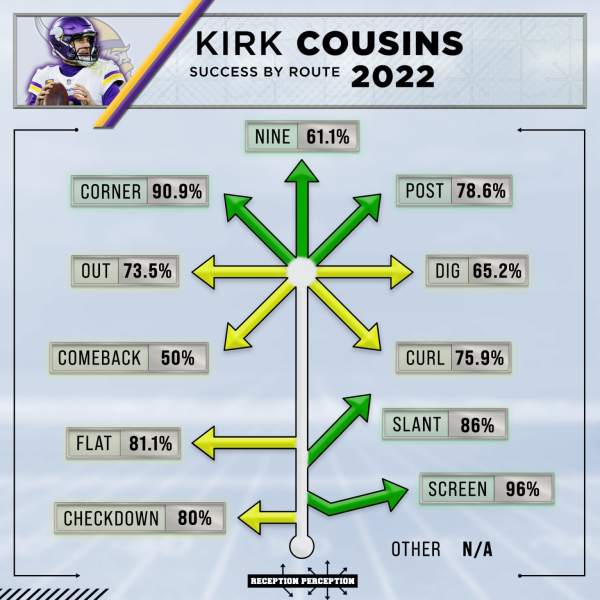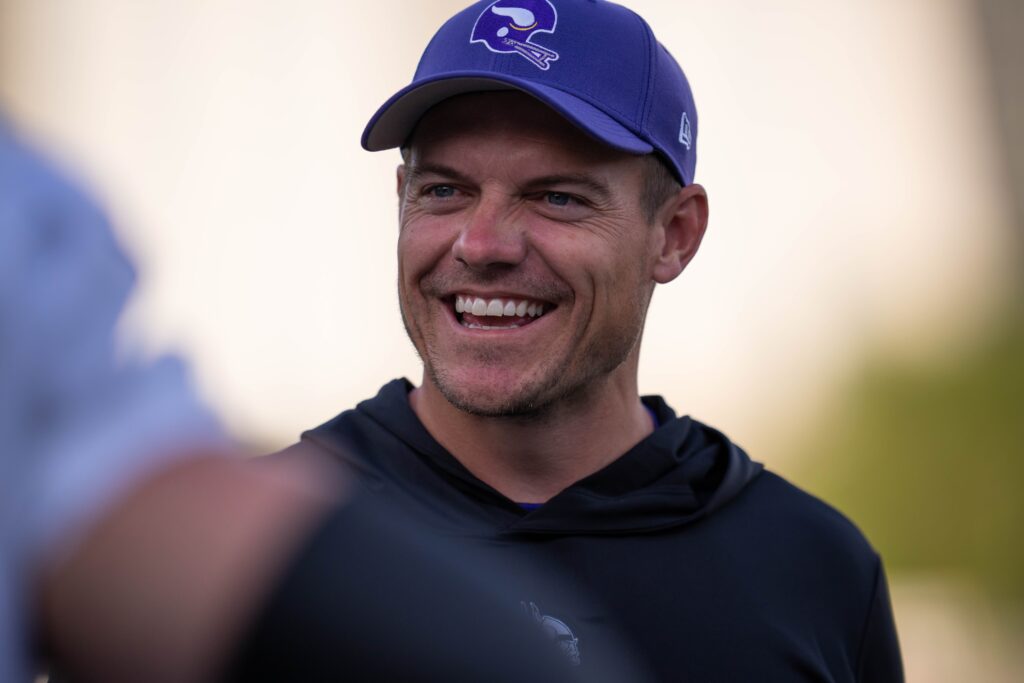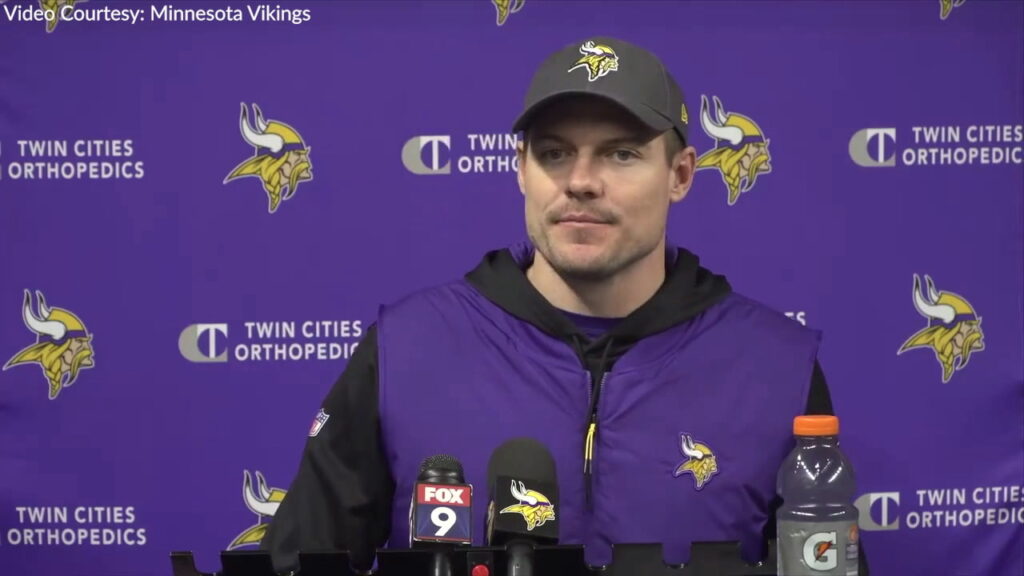EAGAN — When Kevin O’Connell really gets into the deep depths of football discussion, his hands turn into safeties. Two fists in the air is two safeties deep. One fist on top of the other is single-high coverage. When his hand flattens out, that’s a receiver running a route. When his fingers curl and point at each other, he’s the quarterback.
On Monday at TCO Performance Center, O’Connell used all of his football teaching body language in a one-on-one conversation with Purple Insider to break down why quarterback Kirk Cousins is one of the most accurate passers in the NFL and all of the intricacies that go into executing three common patterns.
It’s worth explaining why — of all things — accuracy on three specific routes would be the subject of discussion with the Minnesota Vikings’ second-year head coach. (I could have been asking him about guards and kickers, for goodness sake!)
First, because writer Derrik Klassen of the football data website Reception Perception recently tracked every throw by Cousins in 2022 and found that his passes on slants, posts and corner routes were among the best in the NFL. That’s interesting on its own. But beyond that, analyzing the throws with the HC also provided a peak behind the curtain at O’Connell’s attention to detail and thought process that drives his passing attack. And it allowed a first-hand look at what it’s like to learn from him inside the QB room…
Let’s start with the numbers. Here’s the chart from Reception Perception that I showed O’Connell:

You will notice that the three highest accuracy routes are the slant, corner and post routes.
The line of questioning for the Vikings’ head coach was simple: What are the factors that go into those throws? Why is Cousins so good at them?
Off we go…
THE SLANT
The slant is one of the most fundamental football passing concepts in existence. The receiver just runs across the field and beats his man and the quarterback delivers it in rhythm. Joe Montana and Jerry Rice made legendary careers out of it.
However, nobody really makes a career out of it in today’s game.
O’Connell explained that slant routes can be a great way to get a playmaker the football quickly and give him a chance to catch the ball at full speed and break an explosive play but defenses have come up with ways to make that much more difficult than it was back in the day. If you want to throw a slant now, there’s a lot to think about.
“Any in-breaking route in the short or intermediate area, you have to know and see a lot more,” O’Connell explained.
The former quarterback pointed out that running slants against man coverage can be wonderful but defenders have tools in their toolbox to combat it. He used his hands to demonstrate cornerbacks playing off the receivers at the line of scrimmage but having help underneath from linebackers or corners playing tight and having help from safeties. In order to hit the slant, the QB has to see all of that happening or it could turn into a calamity.
That doesn’t mean the Vikings throw it out. Per RP’s stats, 16% of Cousins’s throws were slants of some kind. A huge part of making it work is timing and footwork. There are 3-step, 5-step and 7-step drops on slants. If it’s a 3-step, you better hit the back foot and sling it or don’t throw it at all. Many times though, the slant starts out looking like something else. Maybe the receiver begins the route selling a fade and then turns it into a slant. Well, that takes an extra half tick. O’Connell shows with his feet how quarterbacks are trained to “sit” on their back foot in that case.
“He’s not ready to catch the ball for another half click, sit on the back foot when he’s out of the break and then boom,” he said, making a throwing motion.
Subscribe: Sign up for our free MINNESOTA VIKINGS newsletters
O’Connell talked another key part: The eyes. You best not be staring down that receiver unless you want to draw attention his way and get him smacked or the pass picked.
“You’re possibly not able to watch the route because you’re trying to hold those help players inside as long as you can and then throw,” he said, moving his head to give me an idea how the QB would need to look one way and then snap back and throw over the middle.
It starts to make sense why Cousins would be good at these things. He’s technically sound with his footwork and wouldn’t have a problem sitting on his back foot until it was time to trigger the throw. He’s also capable of reading defenders, getting his eyes in the right place and then timing the throw correctly. Stuff like that is how he got here.
How good you want your team to be with slants depends on how much you want to commit to slants. Is it worth repping it over and over in practice to get all the potential defenses and options mastered? The league prefers other options like “choice” routes that give the receiver the ability to keep running across the field if he’s open, settle into a zone or cut back outside depending on what the defense shows. A percentage of the throws tracked by Klassen as “slants” were likely routes where the receiver had other options at the outset of the play.
In weighing whether to dial up a slant, O’Connell also has to understand how the defense thinks. On a 3-step drop, the defensive linemen might snuff out the slant and get their hands up. Now you’re talking about a potential tipped ball and turnover just because you tried to get an easy eight yards.
These connect to two subjects O’Connell thinks about constantly: Risk vs. reward and efficiency with practice time.
THE CORNER
You know what’s worth the risk vs. reward? Corner routes. Cousins’s near 91% accuracy on corners is obscene. Patrick Mahomes only hit 70% accuracy on corners. Joe Burrow? 50%. Not even Aaron Rodgers (87%) matched him.
These throws require calculations by the quarterback to be made at hyper speed. Cousins has to see the receiver’s angle because he might have flattened out his route in front of a zone defender or taken it more vertical if the defender is trailing. That usually happens after the snap and can’t be predetermined. So the height, speed and area of the corner throw is made in the moment.
O’Connell puts it this way: Let’s say you’re golfing and you are about 160 yards from the green. You pull an 8 iron, judge the wind, look at the hazards and what happens if the ball goes short or long. Oh, the pin is in the front? Give me the 9 iron instead. Alright, now line it up and swing. That’s what it’s like to throw a corner route except all of that has to happen in 0.25 seconds — and with dangerous dudes on defense trying to crush your face.
“You have to see the angle and you have a split second. Your computer in the brain has to tell your finish, ‘I’m going to take a little off this and layer the ball up and over or I might drive this throw with anticipation,’” O’Connell said.
Is it just natural for Cousins? Is it his 10,000 practice throws?
“I think it’s a little bit of both,” the Vikings’ head coach said. “The technique and fundamentals — maybe not of the throwing motion but I do believe you can transform from the waist down. Your base balance, body position to throw different types of balls. You have to have the ability to have big field vision, see everything you need to see without it overwhelming your mind to make that split second decision.”
And then there’s the part of the calculous that not every quarterback has the privilege of considering: The JJ Quotient.
O’Connell recalls a corner route thrown to Justin Jefferson against Arizona last year in which the superstar receiver was completely covered but Cousins saw the cornerback’s head was turned away from the ball. He tossed it up in Jefferson’s general direction and allowed the receiver to make a play. O’Connell reenacted all parts of that play as he talked about it.
THE POST
Post routes are about landmarks and receivers who track the ball like they have built-in radar.
Sending a receiver deep over the middle has a lot of the same elements of corner routes where it can be different types of throws but these are less about touch and more about the QB letting it rip. Whether it’s a “drive shot” in the red zone or a bomb over the middle, it isn’t being floated in there.
“That one is hard for the quarterback because every millisecond that they let a guy that runs 4.4 [40-yard dash] run away from them it becomes sheer math at that point,” O’Connell said. “I can throw the ball 65 yards on my best day and he’s going to get 65 yards by the time this ball lands and he’s going to get there fast.”
That’s where the landmarks come in. The quarterback is flinging it to the near upright or the area between the hash and the numbers. Depending on the coverage the QB might be throwing it all the way across the field.
It’s not easy to practice. It isn’t wise to have Jefferson running sprint after sprint 65 yards down the field in August when the Vikings need him for 17 games or Cousins toasting his arm with bomb after bomb. So Cousins often just has to believe that Jefferson is down there somewhere and he will do the rest.
“You have a guy running the post who can make a play on the football,” O’Connell said. “Some guys can run like the wind but that ball goes up and the awkwardness of the catch overwhelms them. Others it’s DeSean Jackson, Justin Jefferson, these deep-ball receivers at that last minute can do something with their shoulders or speed so they’re not suddenly having to jump up like it’s a Hail Mary.”
If you are wondering, Reception Perception has Jefferson succeeding on posts 78% of the time, almost 20% better than his college teammate Ja’Marr Chase and 10% better than Tyreek Hill.
“That’s the stuff you can’t quantify and put data on. As a coach I saw it and I know we can do it but I don’t know how to ever recreate that on a mass scale with every receiver in the room.”
The Vikings need these post routes to hit. Opposing defenses are playing lots of coverages that involve two deep safeties and often times one of them is assigned to JJ. Posts are one of the answers to those coverages. O’Connell gets the fists going, showing all sorts of coverages — two-deep, quarters, quarter-quarter half — each that can be exploited in different ways with posts.
“It’s our job to manipulate the coverage and apply whatever concept it calls for based on what you’re saying,” O’Connell said.
He likes having Jefferson get on the opposing safeties fast, which sometimes means running right at them.
“If you get on a defender’s toes, you force stress,” he said. “They will back up so much we can throw every cut or start panicking and grab and hold.”
He then added that you don’t want to run a quarters variation against two deep and that and NFL defenses are now often playing quarter coverages on one side and half on the other. We were all thinking that, right? Right?
Of course, O’Connell mentions the hard part: He has to scheme ways to protect Cousins and allow him enough time to toss the ball 50 yards in the air. We’ll see whether that can come to fruition to make up more than 5% of throws, as posts did from Cousins last season. Maybe it will be more this year.
THE END
Listening back to our conversation, there was a lot to process. And that was just the 15 minute version. I can’t imagine the Ph.D class on these throws. How anyone plays quarterback in the NFL with that level of detail at those speeds is unthinkable. But the other takeaway beyond that Cousins won’t be so easy to replace when it comes to these types of throws was that the Vikings have a head coach who deeply analyzes every nuance of every passing concept and weighs way more than we would ever think before scheming up something or calling a play into Cousins’s headset.
O’Connell is also a master communicator. If he can get us to understand how these complex concepts work, he can certainly relay it to his quarterbacks in terms (and physical motions) that they can connect with. That would seem to matter quite a bit for the present and future of the Vikings QB position.









